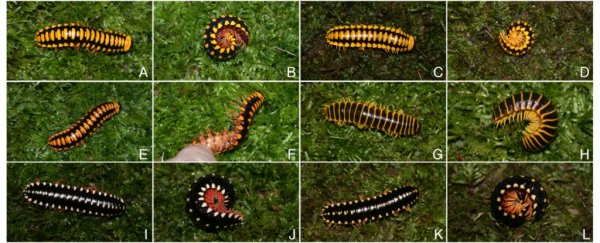A newly discovered millipede has more colour combinations than any other millipede ever discovered - but its bright and striking colouring is a warning that attempting to dine on the arthropod may be biting off more than one can chew.
The multi-legged creature is called Apheloria polychroma. The species is found on the forest floor of Southwest Virginia's Cumberland Mountains, and its colourful carapace is coated with cyanide as a deterrent to predatory birds.
This is actually a fairly common defence mechanism among millipedes, and various species have demonstrated the secretion of hydrogen cyanide and benzoyl cyanide when disturbed.
They also release a host of other chemicals, such as mandelonitrile benzoate and benzaldehyde, both for defensive purposes and perhaps as an antibiotic.
How millipedes use their chemical weapons varies. Some passively ooze them from their glands, others roll up to squeeze them out, and others actively spray them at predators.
Curiously, unlike most living creatures, millipedes themselves are immune to the effects of cyanide; they produce all their chemical weapons in their own bodies.
A. polychroma has been given the vernacular name "Colourful Cherry Millipede". The cherry part isn't actually related to the colour, but refers to the scent of benzaldehyde, an organic compound released by the arthropod.
Apheloria millipedes synthesise benzaldehyde cyanohydrin (mandelonitrile), and store it in special glands. When the millipede feels threatened, it secretes the cyanohydrin, breaking it down into hydrogen cyanide gas, which the millipede releases into its immediate environment.
According to the paper describing this new species, a single millipede from the Apheloria genus can produce enough hydrogen cyanide to kill 18 pigeon-sized birds.
A. polychroma is dangerous enough to produce varied aposematic colouring in the insect, or colouring that warns of toxicity - with at least six different patterns, black with spots ranging from white to yellow to orange, with red or yellow legs, it's the most colourful of all millipedes.
The research team also founds that other millipedes will copy this newly discovered species in what's known as Müllerian mimicry - when creatures that aren't equipped with deadly weapons mimic the colouration of ones that do, thus piggybacking on the reputation of the more dangerous animal.
Although it may seem like the benefit only goes one way, this works in the original animal's favour, too. Predators that see the pattern more often are better able to memorise it, and more effectively stay away.
A. polychroma's discoverer, Paul Marek of Virginia Tech, who previously found the millipede with the most legs ever discovered, is trying to combat anonymous extinction - animals that disappear off the planet without ever being discovered.
"It is imperative to describe and catalog these species so that we know what role they play in the ecosystem - and what impact we are having on them," he said. "This region is ripe with biodiversity and is an excellent living laboratory to do this work."
Millipedes live on the forest floor and feed on decaying vegetation, digesting it and excreting the nutrients it doesn't need back onto the forest floor, where it becomes food for microorganisms, fungus and plants.
The paper describing the discovery has been published in the journal Zootaxa.
